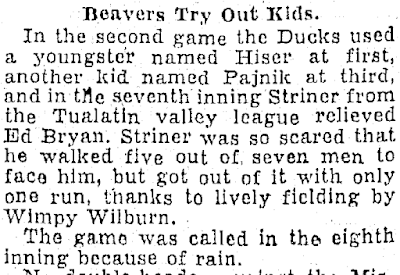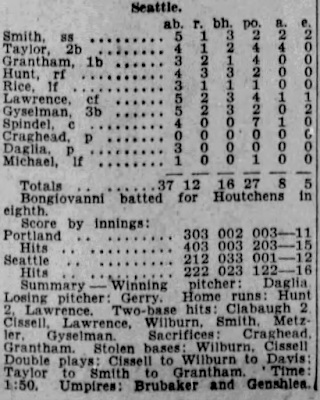As you can see from the screenshots above, the two primary sites for baseball statistics have an unknown "Drew" listed as having been with the Beavers during the 1907 season. Both mention, correctly, that he only made one appearance, and both have his line from that lone outing; but that's where the information stops. As is often the case, I expected that a lot more work would need to be done to identify this mystery player. Turns out though, it only took mere minutes to find his first name, but any other pertinent information about the man himself, or any of his other stops, hasn't been quite as forthcoming.
The July, 31st, 1907 edition of the Morning Oregonian reported that "Pitcher Drew, a strapping young fellow from Wallace, Idaho, has been signed by McCredie, and will be given a chance to make good with the Portland club" [McCredie, for those that may not know, is Walter McCredie, Beavers player, manager, general manager, and part owner]. The Oregon Daily Journal mentioned the following day (August 1, 1907) that "McCredie has signed another bush pitcher. His name is Drew, and he hails from Wallace, Idaho".
One day later, Drew made his debut against the Los Angeles Angels:
 |
| Oregon Daily Journal 8/3/07 |
Before getting to Drew's outing, it's worth noting that "John Drew" is mentioned multiple times in the rather lengthy recaps from both papers, so his first name shouldn't have been a mystery. Clearly, these articles weren't the source for whoever submitted his line to Baseball Reference and Stats Crew. Anyway, back to the game...
August 2nd was "Ladies Day" at Vaughn Street Park, and unfortunately for them, and everyone else in attendance (who were described by the Journal as "one of the biggest and noisiest weekday crowds of the season") pitcher Enon Califf, did what he did so often throughout the 1907 season, started well, and then seemingly lost all interest once things stopped going his way. He threw five scoreless innings, but the Angels finally got to him in the sixth, scoring three runs, and despite his now completely lackadaisical effort, only managed to scored four more in the seventh.
John Drew made his debut in the eighth inning, down 7-2. After a paragraph and change describing Enon's fall, the Journal is quoted as saying "Following came the introduction of a new twirler from the bushes and the breathless curiosity which such a man is always received. The spectators had the delight of watching the new unknown retire the heavy hitter from the south in one-two-three order, only to fall victim to their stick work and their tricks in the next inning".
Describing his entry into the game, the Journal said "He appeared a large young man with a resigned look on his face, and a suit that "fit too quick." He delivers most of his balls with an underhand swing and as McCredie is in the kindergarten business, he may be looked upon as a fairly promising pupil". Upon entering, John struck out Bobby Eager, then closed out the inning by getting both Judge Nagle (pitcher) and Curt Bernard to fly out. "The fans applauded the new "find" loudly, but he did not perform so well in the next inning, which was the ninth". Walter Carlisle started off the inning with a double. Kitty Brashear followed with a sacrifice "which the green youth threw to third when called upon to do so by the Los Angeles coach". Brashear made it to first safely. The rest of the inning as reported is a bit confusing, but it would appear that at least two of the four runs that would be scored came on a wild pitch/throw. Two more were then scored before John struck out the final two batters to end the inning. His final. It's also worth noting that there's a quick aside mentioned during that final sequence in which the "youth" is said to be not as young as Beavers pitchers Hub Pernoll (19), Charlie Hartman (18), and Art Schimpf (21); which may be useful later on.
And that was the extent of John Drew's career with the Beavers. He gave up three hits, four runs, and finished with an ERA of 9.00. On the plus side, he did have three strikeouts. John's trail doesn't quite go cold yet, but we're getting close. Before moving on from this game, in their recap, the Morning Oregonian also provided a few more clues into his background "John Drew, the new pitcher tried out yesterday, hailed originally from California, but recently has been in the Northern part of Idaho working on a ranch. He formerly played ball with Umpire Derrick in California, and several of the Northwestern League clubs have been trying to get him". [Derrick was a controversial presence in the Coast League at the time, not being popular with the fans, coaches, or players. In fact, just a few weeks prior he and Angels captain Frank Dillon got into a physical altercation at the plate during a game in Portland. They ended up having to be separated by a couple of Portland police officers who just happened to be in attendance]
Two days after his outing with the Beavers, John Drew popped up again, this time pitching, and picking up the win, for Cornelius of one of the many amateur city league teams:
 |
| Oregon Daily Journal 8/5/07 |
 |
| Washington County News 9/5/07 |
I have not been able to find anything about him after this. Nor have I been able to find anything else about him prior to his coming to Portland. There are a number of unknown Drew's that played earlier than this, including a pitcher for the Portland Browns in 1904 (which I'm pretty sure isn't the same guy), but I haven't been able to conclusively match any up to John. I suspect that he may've been in his mid to late 20's by 1907. This is deduced not only by what the Journal said about his age, but also by his buying a cigar store. That doesn't seem like something that someone in their late teens to early twenties would've done; even at that time.
I may come back to this at some point, but for the moment I've spent more than enough time just getting this far. And a final word of caution for any potential future researchers, there will be much frustration to be had when searching for John Drew in what are primarily West Coast newspapers, as the well known stage actor, John Drew, was working up and down the coast at this time, and the majority of your hits are going to be about him. It can, and will, start to feel like a lesson in futility in a very short amount of time.
.png)
.png)























.png)
.png)
.png)
